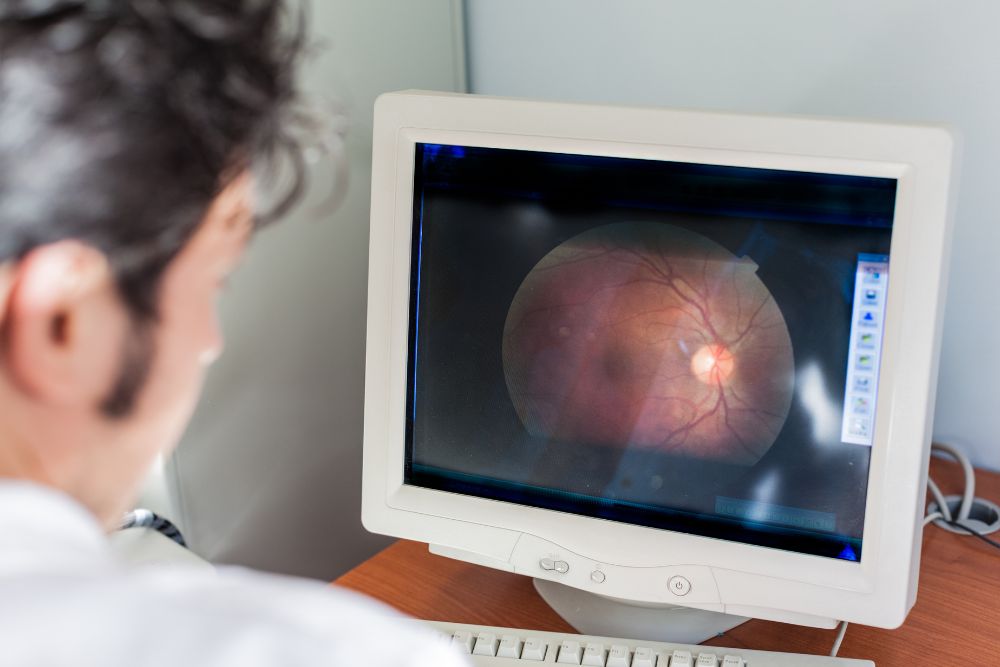From Dry AMD to Geographic Atrophy: How to Protect Your Vision

Living with dry age-related macular degeneration (AMD) often means facing the unknown, leaving many wondering if their condition can progress into something more serious, such as geographic atrophy (GA). Luckily, a majority of patients with dry AMD do not progress to GA, especially with vigilant care. By staying informed and working closely with your retina specialist, you can monitor for changes, protect your vision, and lower your risk of disease advancement.
Understanding the Progression of Dry AMD
AMD occurs when cells of the macula–the part of the retina responsible for sharp central vision–begin to weaken and show signs of dysfunction. Early on, this often appears as drusen, tiny deposits of proteins and cellular waste that accumulate under the retina. At this stage, most patients experience little to no changes in their vision.
As the condition advances, drusen may become larger and more numerous, with patients beginning to notice changes in their central vision, including blurriness, difficulty seeing fine details, and trouble navigating in low lighting. Over time, for some patients, the build-up of drusen can lead to death of macular cells, leaving patches in the retina that cause significant blind spots and distortion to vision. Although most patients with dry AMD do not progress to this stage, which is referred to as geographic atrophy, your risk might be higher if you are:
- 60 or older
- A current or past smoker
- Have a family history of AMD or other eye diseases
- Have a diet lacking in fruits and vegetables
- Have had excessive unprotected exposure to sunlight
Knowing whether you fall into one of these groups can help guide how closely you and your doctor should keep track of your eye health.
Protecting Your Vision
One of the most important steps you can take is to see your retina specialist regularly. Even when your vision feels stable, comprehensive exams and imaging tests can reveal early changes long before you notice them yourself. Detecting progression early gives you and your doctor the best chance to act quickly and preserve your sight.
For many patients with dry AMD, specially formulated vitamin supplements may be recommended. The AREDS2 formula—containing antioxidants like vitamin C, vitamin E, zinc, copper, lutein, and zeaxanthin—has been shown to help slow the progression of intermediate AMD to more advanced stages. Your retina specialist can help determine whether these supplements are right for you.
Additionally, healthy lifestyle choices can play a powerful role in protecting the macula. Providers typically recommend:
- Quitting smoking
- A diet rich in leafy greens, colorful fruits and vegetables, and foods high in omega-3 fatty acids
- Keeping blood pressure, cholesterol, and blood sugar within healthy ranges
- Protecting your eyes from ultraviolet (UV) light with sunglasses and hats
Taken together, these steps don’t cure dry AMD, but they do give you more control over how the condition affects your vision. Staying engaged in your care through both regular monitoring and daily habits can make a significant difference in protecting your sight for as long as possible.
Emerging Treatments and Clinical Trials
Until recently, patients with advanced dry AMD (geographic atrophy) had no treatment options. Today, that is beginning to change. Two recently FDA-approved medications, Syfovre (pegcetacoplan) and Izervay (avacincaptad pegol), have been found to slow the rate of cell loss in the retina, helping preserve vision for longer. These therapies represent a major step forward in the care of GA. Ongoing clinical trials are also underway, exploring additional approaches, such as gene therapy and retinal implants, to provide more effective options in the future.
Schedule an Eye Exam
A diagnosis of dry AMD does not mean sudden or inevitable blindness. For many, the condition progresses slowly, and with today’s advances in care, there are more ways than ever to intervene. However, early detection remains the single most powerful tool to preserve vision.
When AMD is caught early, there are often more options to slow progression while relying on the least invasive treatments. With timely care and the right support, you can protect your vision and continue living fully. If you’ve been diagnosed with dry AMD—or are noticing changes in your vision—schedule an appointment with our team today to ensure your eyes get the care you need.

